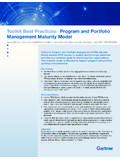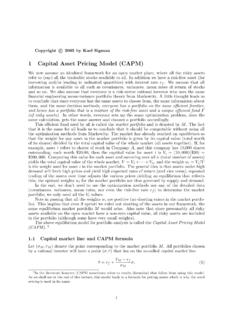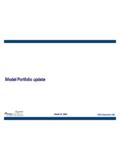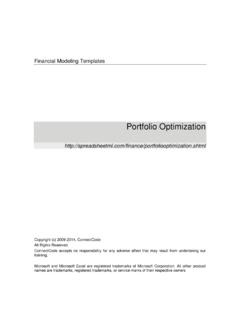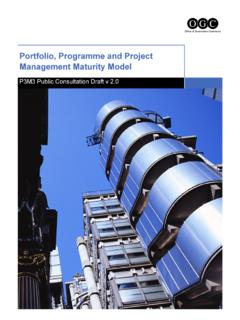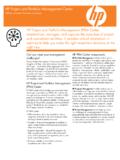Transcription of The Cognitive Theory of Multimedia Learning
1 The Cognitive Theory of Multimedia Learning Stephen D. Sorden Mohave Community College/Northern Arizona University Abstract Multimedia Learning is a Cognitive Theory of Learning which has been popularized by the work of Richard E. Mayer and others. Multimedia Learning happens when we build mental representations from words and pictures. The Theory has largely been defined by Mayer s Cognitive Theory of Multimedia Learning . Generally, the Theory tries to address the issue of how to structure Multimedia instructional practices and employ more effective Cognitive strategies to help people learn efficiently. Baddeley s model of working memory, Paivio s dual coding Theory , and Sweller s Theory of Cognitive load are integral theories that support the overall Theory of Multimedia Learning . The Theory can be summarized as having the following components: (a) a dual-channel structure of visual and auditory channels, (b) limited processing capacity in memory, (c) three memory stores (sensory, working, long-term), (d) five Cognitive processes of selecting, organizing, and integrating (selecting words, selecting images, organizing work, organizing images, and integrating new knowledge with prior knowledge), and Theory -grounded and evidence-based Multimedia instructional methods.
2 Important considerations for implementing the Theory are discussed, as well as current trends and future directions in research. Introduction The Cognitive Theory of Multimedia Learning was popularized by the work of Richard E. Mayer and other Cognitive researchers who argue that Multimedia supports the way that the human brain learns. They assert that people learn more deeply from words and pictures than from words alone, which is referred to as the Multimedia principle (Mayer 2005a). Multimedia researchers generally define Multimedia as the combination of text and pictures; and suggest that Multimedia Learning occurs when we build mental representations from these words and pictures (Mayer, 2005b). The words can be spoken or written, and the pictures can be any form of graphical imagery including illustrations, photos, animation, or video.
3 Multimedia instructional design attempts to use Cognitive research to combine words and pictures in ways that maximize Learning effectiveness. Cognitive Theory of Multimedia Learning 2 The theoretical foundation for the Cognitive Theory of Multimedia Learning (CTML)draws from several Cognitive theories including Baddeley s model of working memory, Paivio s dual coding Theory , and Sweller s Theory of Cognitive Load. As a Cognitive Theory of Learning , it falls under the larger framework of Cognitive science and the information-processing model of cognition. The information processing model suggests several information stores (memory) that are governed by processes that convert stimuli to information (Moore, Burton & Myers, 2004). Cognitive science studies the nature of the brain and how it learns by drawing from research in a number of areas including psychology, neuroscience, artificial intelligence, computer science, linguistics, philosophy, and biology.
4 The term Cognitive refers to perceiving and knowing. Cognitive scientists seek to understand mental processes such as perceiving, thinking, remembering, understanding language, and Learning (Stillings, Weisler, Chase, Feinstein, Garfield, & Rissland, 1995). As such, Cognitive science can provide powerful insight into human nature, and, more importantly, the potential of humans to develop more efficient methods using instructional technology (Sorden, 2005). Key Elements of the Theory The Cognitive Theory of Multimedia Learning (CTML) centers on the idea that learners attempt to build meaningful connections between words and pictures and that they learn more deeply than they could have with words or pictures alone (Mayer, 2009). According to CTML, one of the principle aims of Multimedia instruction is to encourage the learner to build a coherent mental representation from the presented material.
5 The learner s job is to make sense of the presented material as an active participant, ultimately constructing new knowledge. According to Mayer and Moreno (1998) and Mayer (2003), CTML is based on three assumptions: the dual-channel assumption, the limited capacity assumption, and the active processing assumption. The dual-channel assumption is that working memory has auditory and visual channels based on Baddeley s (1986) Theory of working memory and Paivio s (1986; Clark and Paivio, 1991) dual coding Theory . Second, the limited capacity assumption is based on Cognitive load Theory (Sweller, 1988,1994) and states that each subsystem of working memory has a l imited capacity. The third assumption is the active processing assumption which suggests that people construct knowledge in meaningful ways when they pay attention to the relevant material, organize it into a coherent mental Cognitive Theory of Multimedia Learning 3 structure, and integrate it with their prior knowledge (Mayer, 1996, 1999).
6 The Three Store Structure of Memory in CTML CTML accepts a model that includes three memory stores known as sensory memory, working memory, and long-term memory. Sweller (2005) defines sensory memory as the Cognitive structure that permits us to perceive new information, working memory as the Cognitive structure in which we consciously process information, and long-term memory as the Cognitive structure that stores our knowledge base. We are only conscious of information in long-term memory when it has been transferred to working memory. Mayer (2005a) states that sensory memory has a visual sensory memory that briefly holds pictures and printed text as visual images; and auditory memory that briefly holds spoken words and sounds as auditory images. Schnotz (2005) refers to sensory memory as sensory registers or sensory channels and points out that though we tend to view the dual channel sensors as eye-to-visual working memory and ear-to-auditory working memory, that it is possible for other sensory channels to introduce information to working memory such as reading with the fingers through Braille or a deaf person being able to hear by reading lips.
7 Working memory attends to, or selects information from sensory memory for processing and integration. Sensory memory holds an exact sensory copy of what was presented for less than .25 of a second, while working memory holds a processed version of what was presented for generally less than thirty seconds and can process only a few pieces of material at any one time (Mayer 2010a). Long-term memory holds the entire store of a person s knowledge for an indefinite amount of time. Figure 1 is a representation of how memory works according to Mayer s Cognitive Theory of Multimedia Learning . Figure 1 Mayer s Cognitive Theory of Multimedia Learning (Mayer 2010a) Mayer (2005a) states that there are also five forms of representation of words and pictures that occur as information is Cognitive Theory of Multimedia Learning 4 processed by memory.
8 Each form represents a particular stage of processing in the three memory stores model of Multimedia Learning . The first form of representation is the words and pictures in the Multimedia presentation itself. The second form is the acoustic representation (sounds) and iconic representation (images) in sensory memory. The third form is the sounds and images in working memory. The fourth form of representation is the verbal and pictorial models which are also found in working memory. The fifth form is prior knowledge, or schemas, which are stored in long-term memory. According to CTML, content knowledge is contained in schemas which are Cognitive constructs that organize information for storage in long term memory. Schemas organize simpler elements that can then act as elements in higher order schemas. As Learning occurs, increasingly sophisticated schemas are developed and learned procedures are transferred from controlled to automatic processing.
9 Automation frees capacity in working memory for other functions. This process of developing increasingly complicated schemas that build on each other is also similar to the explanation given by Chi, Glaser, and Rees (1982) for the transition from novice to expert in a domain. The Development of the Theory of Working Memory The current conception of working memory in CTML grew out of Atkinson & Shiffrin s (1968) model of short term memory. The Atkinson & Shiffrin model was viewed primarily as a structure for temporarily storing information before it passed to long-term memory. Eventually, researchers began to question some of the assumptions of short-term memory and a few started to look for better explanations. Baddeley and Hitch (1974) subsequently proposed a more complex model of short-term memory which they called working memory.
10 Their model for working memory was a system with subcomponents that not only held temporary information, but processed it so that several pieces of verbal or visual information could be stored and integrated. Baddeley (1986, 1999) later proposed that there was an additional component in working memory called the central executive. According to the Theory , the central executive controlled the two subcomponents of working memory, known as the visuo-spatial sketch pad and the phonological loop. The central executive also was responsible for controlling the overall system and engaging in problem solving tasks and focusing attention. Baddeley theorized that the central executive could transfer storage tasks to the two subcomponent systems in working memory, so that the central Cognitive Theory of Multimedia Learning 5 executive would continue to have capacity for performing more demanding selection and information processing tasks.


